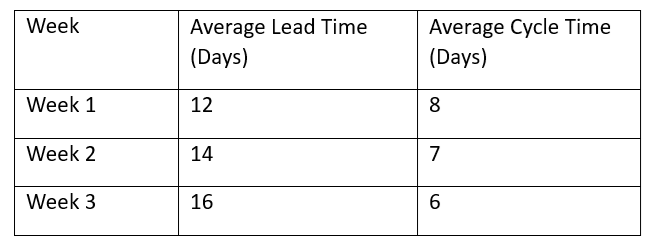PMI-ACP Practice Questions #118
You are managing a mobile app development team and tracking lead time and cycle time over the last three weeks to improve delivery efficiency.

What could be the most likely cause of this trend, and what should the team focus on?
A. The team is facing too many blockers in the development process, delaying progress and increasing lead time.
B. Work is waiting too long in the backlog, possibly due to unclear priorities or demand exceeding capacity.
C. The team’s work-in-progress (WIP) is increasing week over week, leading to longer wait times before new work starts.
D. The faster work completion rate is causing rework and inefficiencies, impacting overall delivery quality.
Analysis
The given sprint data tracks lead time and cycle time trends over three weeks. Lead time is the total time taken from when a work item is requested until it is delivered, while cycle time is the duration from when the team starts working on an item until it is completed.
From the data:
- Lead time is increasing (12 → 14 → 16 days)
- Cycle time is decreasing (8 → 7 → 6 days)
This indicates that while the team is completing work faster once they start, the waiting time before work begins is growing. The most likely reason is that work is waiting too long in the backlog before being picked up, possibly due to unclear priorities or demand exceeding capacity.
Analysis of Options
A: The team is facing too many blockers in the development process, delaying progress and increasing lead time.
This is incorrect because blockers would typically slow down cycle time (how long it takes to complete an item once started). However, in this case, cycle time is decreasing, meaning work is progressing smoothly once started. The issue lies in work waiting too long before development begins, not delays during development.
B: Work is waiting too long in the backlog, possibly due to unclear priorities or demand exceeding capacity.
This is correct. Since lead time is increasing while cycle time is decreasing, it suggests that work is spending more time in the backlog before being worked on. This could be due to unclear prioritization, excessive incoming work, or bottlenecks in decision-making. The team should focus on improving backlog management, refining priorities, and ensuring a smoother flow of work.
C: The team’s work-in-progress (WIP) is increasing week over week, leading to longer wait times before new work starts.
This is incorrect because if WIP was increasing, cycle time would also increase due to context switching and multitasking. However, in this case, cycle time is decreasing, suggesting that WIP is not the main issue. The problem is more about work waiting too long before being started, rather than excessive parallel work.
D: The faster work completion rate is causing rework and inefficiencies, impacting overall delivery quality.
While a faster work completion rate can sometimes lead to rework and inefficiencies, there is no data in the question to indicate that quality issues or rework are occurring. The increasing lead time is more likely due to backlog delays rather than inefficiencies in execution.
Conclusion
The best answer is Option B: Work is waiting too long in the backlog, possibly due to unclear priorities or demand exceeding capacity. The trend of increasing lead time but decreasing cycle time strongly suggests that work items are spending more time waiting before being picked up. To improve efficiency, the team should focus on refining backlog management, improving prioritization, and ensuring smoother flow of work into development.
PMI – ACP Exam Content Outline Mapping
| Domain | Task |
| Delivery | Manage Agile Metrics |
Topics Covered:
- Understanding and analyzing Agile metrics: Lead Time vs. Cycle Time
- Identifying causes of delayed work initiation despite efficient execution
- Backlog prioritization and demand management
- Improving flow efficiency through better backlog and capacity alignment
- Using Agile metrics for continuous delivery improvement
If you’re preparing for the PMI Agile Certified Practitioner (PMI-ACP)® Exam, we highly recommend enrolling in our PMI-ACP® Exam Prep Program. Designed to provide a comprehensive Agile learning experience, this program not only helps you ace the PMI-ACP® exam but also enhances your Agile mindset, leadership skills, and ability to deliver value-driven projects. Ensure exam success and career growth with our expert-led, structured preparation program tailored for Agile professionals.